Household knives require sharpening from time to time. Especially quickly they begin to become dull under increased side load, when pieces of metal come off the edge, or when cutting solid objects at right angles. The main goal of sharpening household knives is to keep the sharpness of the cutting edge as long as possible, removing as little metal as possible from it when sharpening. To achieve this, you need to know how to properly sharpen knives with a bar, because this is the most common sharpening option at home.
Grinding stones come in several varieties: diamond, ceramic, natural, Japanese water. In addition, grinding devices are also electric type. Without the skills of sharpening knives at home, it is better to use an ordinary abrasive or ceramic whetstone. Electric sharpeners can ruin the blade in the absence of the necessary skills or low-quality tools. In order to straighten the blade, you should use the musat.
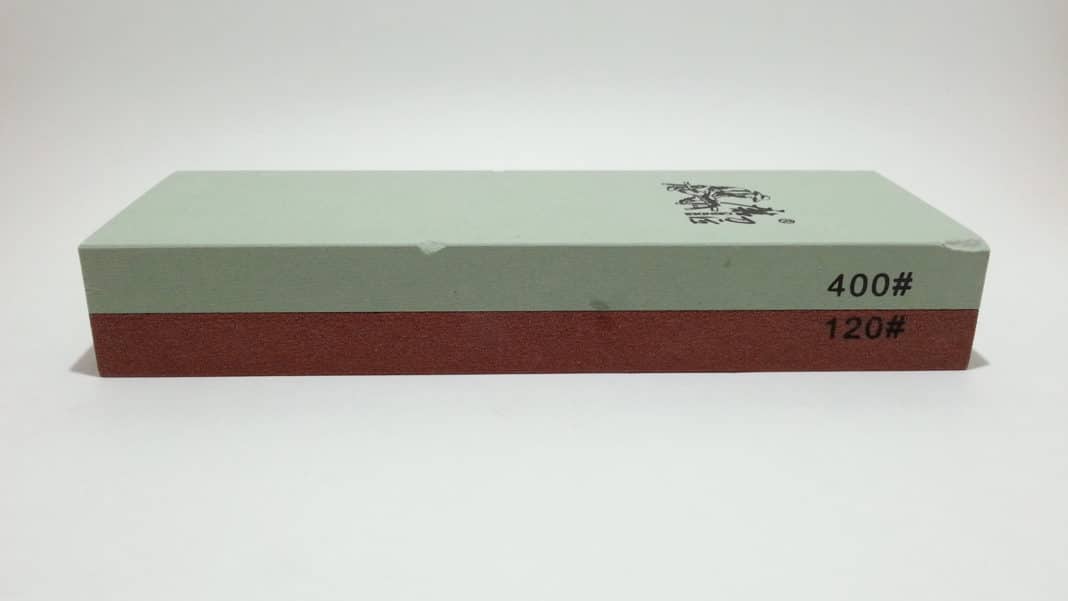
To sharpen a knife well, you must use at least two abrasive bars, one of which has a large grain size, the second - a smaller one. The blade is sharpened with one whetstone, and polished with the second.
The correct bar should have a length 1.5-2 times the length of the knife, its surface should be even, without chips. To begin with, it is better to purchase a stone of medium hardness, and when the necessary skill appears, purchase several various stones for different degrees of sharpening and type of steel. best quality sharpening is still characterized by Soviet-made stones, if you managed to find such a bar somewhere at a flea market, then you are lucky, and the quality of sharpening with a long service life is guaranteed.
In addition to sharpening knives with bars, you can use goy paste to form a sharp cutting edge. To have not only a theoretical idea, but also a practical one, it is better to watch a video on how to properly sharpen knives with a bar.
How to sharpen knives with a bar by hand

When sharpening knives by hand, it is necessary to start with an abrasive with a large grain and finish with a fine grain. In doing so, the following principles are recommended:
- Knives are sharpened with smooth movements, without pressure on the cutting edge.
- It is necessary to choose the optimal sharpening angle and observe it throughout the entire process of sliding along the bar.
- Before sharpening, during the process itself and as it ends, it is necessary to moisten the whetstones with water or soapy water. This is necessary for a better glide of the blade, to avoid clogging the pores of the stone with metal dust, as well as to get rid of the dirt that appears during the process and clean the stone after sharpening.
- The first attempt at sharpening an edge is best done on a knife that you won't mind ruining.
- The sharpening pass is made with the cutting edge forward, “away from you”. Sharpening starts from the location of the handle. As the blade moves along the bar, the knife is pulled towards itself so that, reaching the end of the grindstone, it simultaneously reaches the end of the point.
- Ceramic knives are hard and retain their sharpness well after sharpening, but they are very fragile, unlike steel ones. Sharpening of this type of blades is carried out only with diamond wheels.
The process of sharpening home knives can be described step by step:
- The bar is wetted with soapy water (you can use dishwashing liquid).
- The stone is placed on flat surface- a table, a cutting board in a position convenient for you.
- The desired sharpening angle is selected to fix the position of the knife. When sharpening it at a certain angle, it is worth remembering: the smaller it is, the sharper the cutting edge is, and the larger it is, the longer it will remain sharp.
- For different types kitchen knives choose their own angle: for a regular knife it is 40-45 degrees, for a sirloin knife, designed for thin slicing of fish, poultry or meat, the sharpening angle should be 30-40 degrees. Other tools have their own values: 10-15 degrees for razors and scalpels; 15-20 - for cutting vegetables, bread; 25-30 - angle for sharpening hunting knives. To get the correct angle that must be observed between the blade and the bar, it is necessary to divide these recommended values \u200b\u200bby two. Thus, to sharpen a 45-degree edge, each side of the blade must be sharpened at 22.5 degrees relative to the grinding surface.
- The knife is placed in such a position that the upper part of the handle is under the lower edge of the bar. One hand holds the handle, the other - the cutting edge, then you need to start sliding the blade away from you from the bottom of the knife to the tip in the direction of travel.
- The cutting edge must be perpendicular to the direction of travel.
- The angle is maintained throughout the movement, with the knife handle lifted on the curve of the blade to maintain a certain angle.
- You will need to make at least 40-50 sliding movements on one side, then turn the knife over and repeat the same steps on the other side. A sign that the edge has begun to sharpen will be the appearance of characteristic "burrs" on the blade. As you sharpen, metal dust will appear, which must be removed from the surface of the grindstone.
- When the point is sharpened, it is necessary to start finishing the blade. To do this, you need to perform the same steps as described above, but on a stone with less grit. Musat will act as an alternative to such a bar. This is a steel round rod with longitudinal notches for straightening the edge. It is not suitable for sharpening, and it is useless for a knife that is too dull, but it will help to edit the knife before and after working with it. To use the musat correctly, it should be held strictly vertically. The blade moves along the musat at an inclination of 20-25 degrees no more than 4-5 times on each side of the blade.
- If you need to achieve a high degree of sharpness of the blade, like a razor, you can use goy paste. She needs to process the entire edge of the knife and repeat all the sharpening steps described above with the only difference that sharpening is done in the direction from the cutting edge.
To simplify the process of sharpening at the right angle, special templates can be made. To do this, on thick paper with the help of a protractor, an angle of 30, 40, 45, 22.5 degrees is marked. A corner is formed from it in accordance with the desired value, and the position of the blade relative to the surface of the whetstone during sharpening is measured from this corner.
How to sharpen knives with a bar: an alternative

If there is no desire or opportunity to use a whetstone, you can sharpen the blade in alternative ways:
- The easiest way is to sharpen on the rough edge of a ceramic saucer located below it. The principle of sharpening is the same as described above, the main thing is to observe the angle of inclination, direction and smoothness of movement.
- Electric sharpener - convenient and fast way blade sharpening, can work even with very dull blades, including ceramic knives. Often used in catering places to work with a large number of tools. But the catch in its application lies in the fact that it will remove too a large number of metal from the blade, which causes the knife to wear quickly. In addition, an electric sharpener is not the cheapest way to sharpen a blade.
- Roller sharpener for knives. This is an inexpensive and easy way, but far from the most effective, because the sharpness of the blade does not last long. A mechanical V-sharpener is also cheap and quick to sharpen, but damages the blade a lot.
- Sharpening systems allow you to precisely adjust and maintain the required angle. Sharpening systems come with the ability to fix the blade and the grindstones themselves at a certain angle. The main disadvantage of these systems is that not every type of kitchen knife can be sharpened with them.
Sharpening the blade using an emery machine. This is an effective, but inconvenient way for home use, and even more so for a beginner. Blade sharpening is carried out using several types of wheels: abrasive, felt, grinding. This method is often used to sharpen large hunting blades.
- Choosing a knife blade and assessing its quality
- Sharpening with a whetstone
- Important tips for sharpening with an electric sharpener
- The choice of angle when sharpening according to the type of knife
- Methods of final sharpening (finishing)
- Ways to check the quality of sharpening
Previously, the process was considered an important skill for any man. After all, success in hunting and other complex matters depended on the quality of this work. Knives were used almost everywhere: from the extraction and processing of food, animal skins to interpersonal warfare and asserting territory.
Due to the fact that the knife is practically an essential item in the kitchen, it becomes dull very quickly and requires sharpening.
To date, knives are not used so seriously, but the breadth of their application has not lost its range. They stay the same necessary tools in the kitchen in the process of processing and cooking, for the repair of various products, and also for art.
Choosing a knife blade and assessing its quality
With good sharpening, the knife will serve you for a very long time, without requiring additional sharpening of the blade. But still, the duration of the tool’s operation will still largely depend on the quality of the knife itself, and in particular on the material from which the blade is made.
Today the market produces many different knives. Moreover, many manufacturers consider their products to be universal and almost eternal. But advertising always does its job to increase demand for the product. Therefore, it is more reasonable to learn at least the minimum criteria for selecting a knife blade and the timely choice of material for sharpening it specifically.
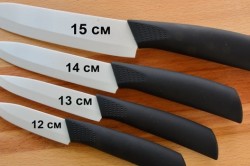
As the size of the knife increases, the material should be thicker and stronger.
- The larger the knife, the thicker the blade should be. At the same time, the main thickness does not look at the sharpened, but at the upper blunt side. Here everything should be proportional. Very big knife should not have a too thin blade even on the cutting part, while a small knife will be thin in itself, and the blade will have a thickness barely noticeable to the eye.
- Accordingly, the larger the knife, the stronger steel it is made of. Therefore, it will need to be sharpened more carefully and for a long time. It is recommended that the largest cutters be sharpened exclusively on diamond blades or on the most powerful electric sharpeners, since the use of a stone in this case is useless.
- When buying a knife, be sure to check its degree of flexibility. A good blade won't bend at all. But if the knife is very thin and yet tends to bend, then it is important that the blade immediately return to its original place. That is, irreversible deformation is a sign of a very poor quality of the material itself.
Back to index
Sharpening with a whetstone
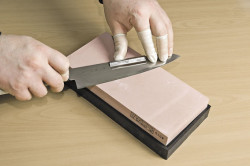
For high-quality sharpening of knives, you can completely do with a special grindstone.
There are quite a few methods for sharpening knives. The choice of a particular method largely depends on the willingness to spend your money and time, and also on the scope of a particular knife. Therefore, to begin with, we will consider the most inexpensive and long-established method - sharpening with a special stone. And then we will briefly dwell on mechanical sharpening.
There are two main types of sharpening stones: artificial and natural. Artificial stone has a larger fraction, it is also larger in size. In modern artificial materials of this kind, one side is usually less aggressive, and the other has larger grains, which makes the stone suitable for sharpening even large and very blunt instruments.
Natural stone for sharpening is somewhat cheaper, and it also has a fine-grained structure on both sides. Therefore, it is more appropriate to use it for sharpening knives that are not too dull and for maintaining the sharpness of blades with soft metal from time to time.

Before starting, the grindstone should be lubricated with vegetable oil.
Now start sharpening. But first you need to oil the stone, whatever it is. You can use a small amount of ordinary sunflower oil. It is necessary to lubricate the entire bar from all sides, and then let the oil soak in for about 7-10 minutes. This will make small particles less vulnerable to microscopic pieces of metal from the knife clogging them during the sharpening process. Therefore, the stone will serve you much longer.
You can start the main process. Sharpening is done in two stages: first with the rough side, and then with the softer side. This applies directly to bilateral artificial stones. The knife must be wiped from dust and applied to the stone like this, while driving the blade with force in the indicated direction.
The aggressive part of the grindstone will make it possible to quickly remove the main blunt layer of metal from the knife. It should be noted that it is desirable to try to hold the knife at an angle of about 20-25 °. This figure is considered optimal for fast and high-quality sharpening. However, given the fact that knives today are very different in their forms, you can be too biased not to take this recommendation, but to approach your work creatively.

During sharpening, you need to try to make smooth movements, pressing enough on the blade. Approaching the edge, it is recommended to slightly raise the blade, due to which the sharpening will turn out to be of better quality. At the same time, observe the perpendicularity of movement relative to the cutting part of the knife.
It is necessary to sharpen the knife on the aggressive side of the stone carefully, periodically checking the opposite side of the blade. A sign that the main sharpening is over will be the presence of small notches on the tip of the blade.
Back to index
But today, not everyone wants to sharpen knives with a stone, no matter how good it is. Therefore, an electric sharpener is used for this purpose. It is usually used in large enterprises for the manufacture of tools and various household materials from metals, as well as in metallurgical shops.
Sharpening a knife on an electric sharpener is much easier and faster. It makes no sense to focus too much on the angles while holding the tool, as modern electric sharpeners are able to independently adjust the degree of inclination. Knowing that the process is much faster on a sharpener, consider a few important points:

- To sharpen a knife that will serve exclusively as a tool for cutting food, it is enough to sharpen the knife for about 5 minutes (this is if it is almost completely dull). The angle of inclination can be taken to the minimum.
- If you want to achieve maximum sharpness of the blade, then it is important to sharpen one side until pronounced burrs appear. When they become clearly visible, turn the knife over to the other side and continue sharpening until the burrs are removed and the blade is very thin.
- As a finishing knife after using an electric sharpener, it is best to use a diamond blade. He is at the very fast time and will remove small notches with the highest quality, making the tool almost ideal for work.
- If you want to update the blade on the sharpener, then for this, experts recommend using standard circles of the EBK brand. white color. Their advantage is that they do not burn through the edges, making the process as delicate as possible.
- When using an electric sharpener, it is important to correctly set its speed. The optimal figure is considered to be approximately 1.5 thousand revolutions per minute. This is the average value at which you will always have time to notice how sharp the blade is, so as not to spoil the material of the knife.
- An important point in electric sharpening is the timely cooling of the edge. The more often it is cooled, the less likely it is to burn the blade. Do not be afraid that with an intensive process, the material acquires a purple hue. With proper and frequent cooling, even this is compensated.
Back to index
The choice of angle when sharpening according to the type of knife
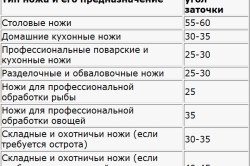
Special attention deserves consideration of the process of sharpening professional expensive knives, as well as individual blades. Since they come in different types, consider the basic rules and sharpening tips, just based on these types of tools:
- Knives for processing meat carcasses are recommended to be sharpened at an angle of 25 °, and tactical tools - from 25 to 30 °.
- For sharpening professional knives for hunting, it is necessary to observe an angle of 35-40 °.
- If you go hunting quite often, then the sharpening angle must be increased to 45 ° - so the knife will serve you sharp much longer than usual.
- The work on the blades of reusable straight razor knives deserves special attention. At the same time, it is necessary to observe the minimum angle of holding the blade during sharpening - about 10 °.
Back to index
Methods of final sharpening (finishing)
After that, you need to finish sharpening. For this, the already fine-grained side of the sharpener is used. The process of removing notches and giving the knife its final degree of sharpness is called finishing. Finishing on the less aggressive side is carried out according to the same rules as on the coarse-grained side. After that, the knife is considered sharpened.
Some deserve special attention alternative ways final sharpening (finishing). As a rule, they are used when special sharpness of the tool is needed. Therefore, it is advisable to consider the most inexpensive alternative methods proofs in more detail.
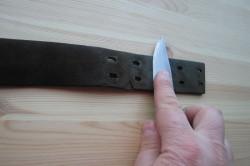
To sharpen a knife, you can use a small piece of genuine leather.
- Using a small piece of genuine leather. Oddly enough, but such material is able to sharpen the blade very well. Before this, it is advisable to remove the notches with a fine-grained stone, and then proceed to processing. First, a piece of leather is wiped from dust and treated with a thin layer of a special paste such as GOI. Then you need to wait 5-7 minutes until the paste penetrates the pores of the skin, and get to work. Fine-tuning by this method is done according to the principle “from the grain” - that is, the knife blade must be kept away from you while working, and moved along the skin in the same way. It is important to turn the blade slightly to the side so that the turning occurs as if diagonally. So the effect will be much better.
- Musat has recently begun to gain great popularity for finishing knives. This is a twig made of steel, on which there are several longitudinal grooves. You need to sharpen a knife on it differently than on a belt or stone. In this case, the knife remains motionless, while the musat itself leads along the blade. You will not achieve the same good effect as from a piece of skin, but you will slightly sharpen the knife, which is important.
- A good effect for finishing knives gives ceramics. The most ordinary cheap dishes are used for this purpose - a cup or plate that you do not need on the farm. Instead, it is better to take a separate piece of ceramic, which you will always use for this purpose. Sharpening is carried out in the same way as on grindstone. Only it is not a smooth, but a rough surface that is chosen (usually concentrated on the outside of the bottom of the vessel). Otherwise, nothing will work.
Sharpening a knife at home is easy. Personally, I do this regularly. I suggest you figure out how to sharpen knives correctly and what tools are best to use for this.
Necessary tools
To learn how to sharpen knives properly, first you need to get acquainted with the tools that you can use for this. Each of them has its own features and advantages:
- Musat. Outwardly, this device resembles an ordinary file. It consists of a long rod of round section, a notch and a handle. Musat is designed to correct the cutting edge of the knife.
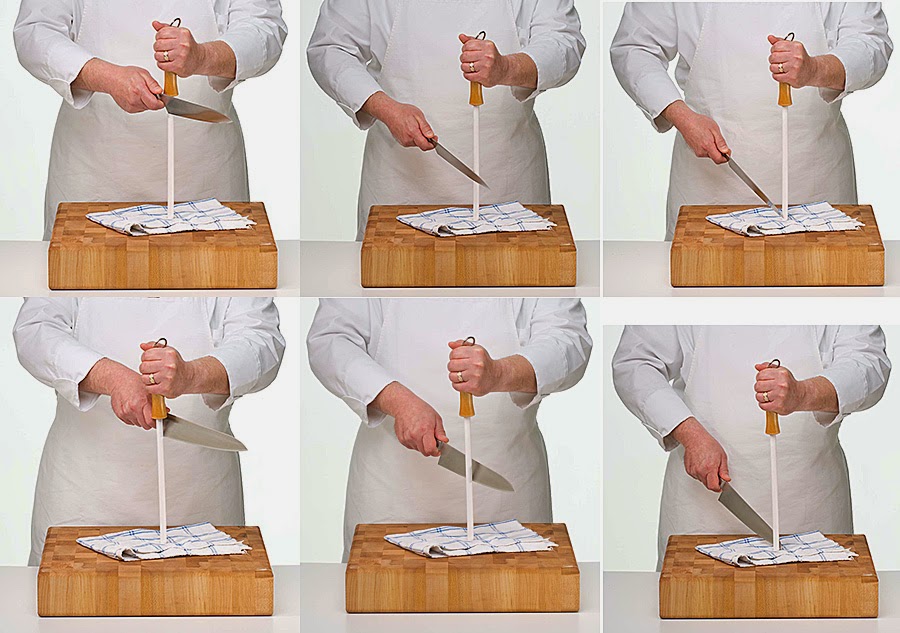
Musats constantly maintain the working condition of the knife. But if the blade is very dull, this tool will not help.
- electric sharpener. great way high-quality sharpening of not only kitchen knives, but also scissors and screwdrivers. In just two minutes, the tool will help you first sharpen and then grind any type of blade.
Sharpen knives properly electrical appliance will not be difficult - he himself determines the required angle of sharpening.

- Mechanical sharpener. Affordable, but not entirely effective. Mechanical sharpeners are popular because of their simplicity, low cost and the ability to restore the blade to its former sharpness. And yet, it is impossible to achieve an ideal result with a mechanical device. In addition, the blade after it soon dulls again.
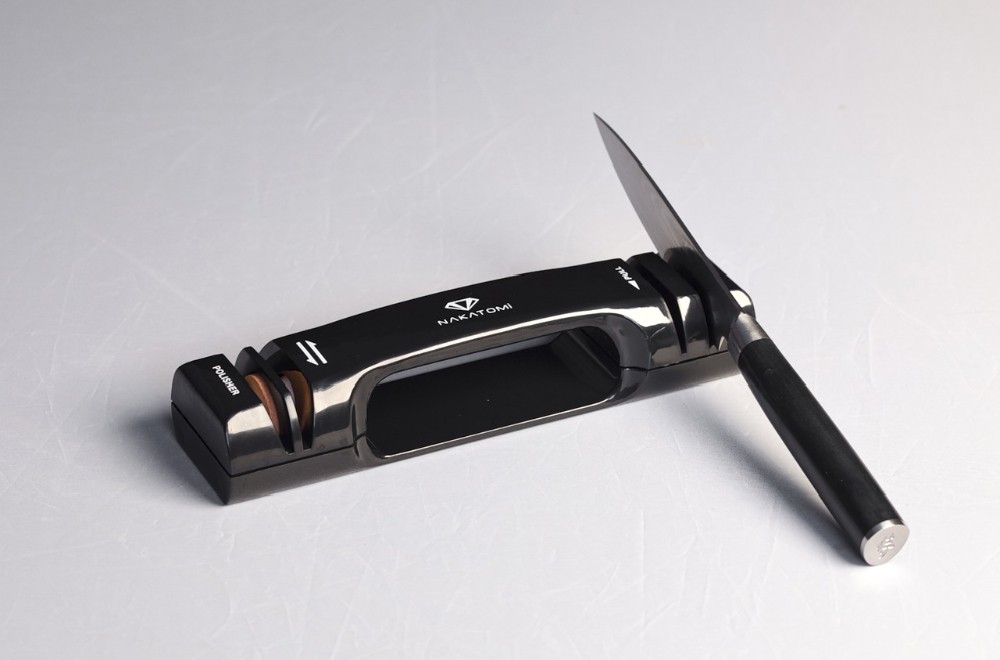
- Machine with abrasive wheel. This is a professional tool that is used, as a rule, in industrial enterprises. On the grinder I do not recommend working without experience. At certain temperature supported on the machine, the material of the knife is hardened, and improper heating will cause irreparable harm to it.

- Grindstone. One of the most effective knife sharpening tools. But the process of using it requires certain skills.
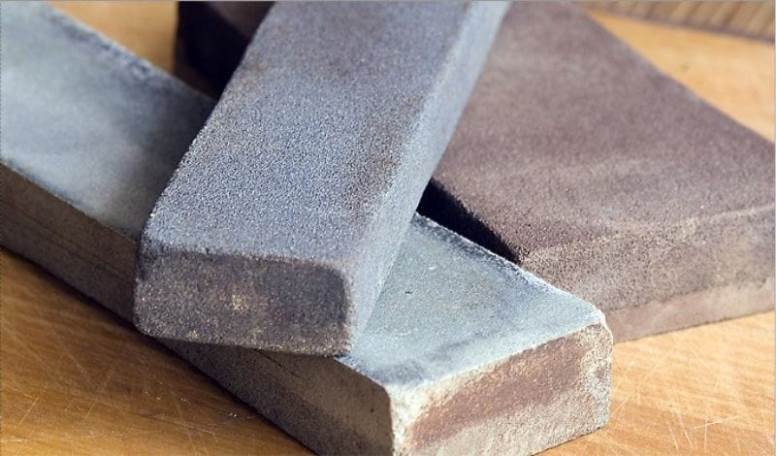
There are several types of tools: diamond, ceramic, Japanese water stones, natural. They differ from each other in the degree of surface graininess (like sandpaper). V natural stones the frequency of grains is usually finer, while artificial ones are produced with varying degrees of graininess on both sides of the bar.
Sharpening a knife with a whetstone
How to sharpen with a whetstone to get a quality result? You need to know which bar is better to choose and at what angle to hold the knife.
Stone selection
In order for sharpening with a stone to be successful, you need to pay attention to it:
- The size. The length of the tool should exceed the length of the blade by about one and a half to two times. In extreme cases - equate to the length of the knife;
- Surface. Carefully inspect the surface of the tool - it should be flat and without chips;
- Functional. You can purchase a universal tool of medium hardness. But it is better to buy a stone with two types of grain size at once.

The choice of the angle of inclination
To achieve the desired result, it is necessary to choose the correct sharpening angle. It depends on the type of knife:
- 25° - for professional cook and sirloin;
- 10°–20° - for Japanese knives;
- 30°–45° - for hunting blades;
- 30° - for kitchen knives.
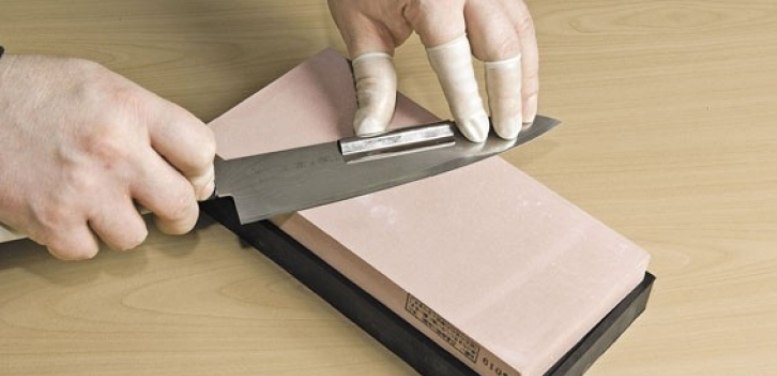
5 steps to sharpening a knife with a stone
So, instructions for the correct sharpening of a kitchen knife with your own hands using a double-sided bar:
| Illustration | Description of actions |
 | Step 1. Preparing the Stone. Before sharpening knives with a bar, it must be prepared. To do this, the tool must be rinsed in water or vegetable oil. |
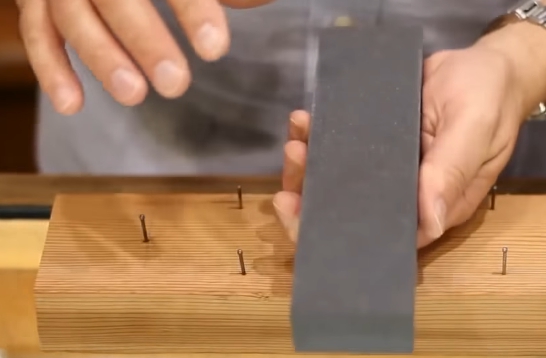 | Step 2 Installing the support. Lay out a wooden kitchen board or other object on the table that can act as a support for the bar. For convenience, you can build a small holder from a wooden block and a few nails, as shown in the photo. |
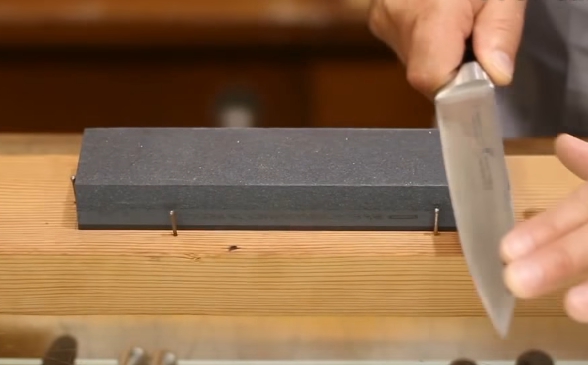 | Step 3. Fixing and getting started. Set the kitchen knife to the desired angle. Remember that a single slope must be observed throughout the work. Make sure that the top of the handle is in contact with the bottom of the bar. Follow the path indicated in the photo. You shouldn’t put too much pressure on the blade, but you don’t just need to iron it either. |
 | Step 4. Main work. Drive alternately with both sides of the blades until a kind of "burr" appears on it. This is a signal that the excess metal has worn out, and there is no point in grinding it further. During the sharpening process, metal dust will appear on the surface, which will need to be washed with water from time to time. |
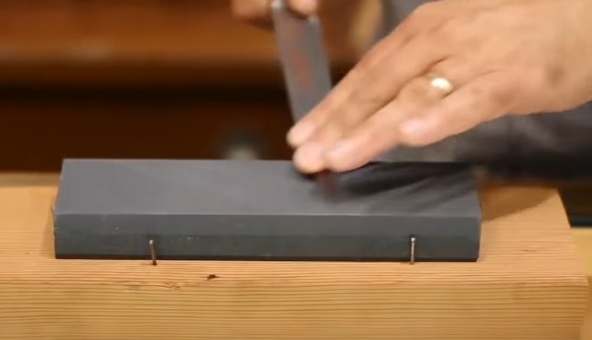 | Step 5. Fine-tuning. Turn the block over with the finer grit side. Sand the blade with the same movements. |
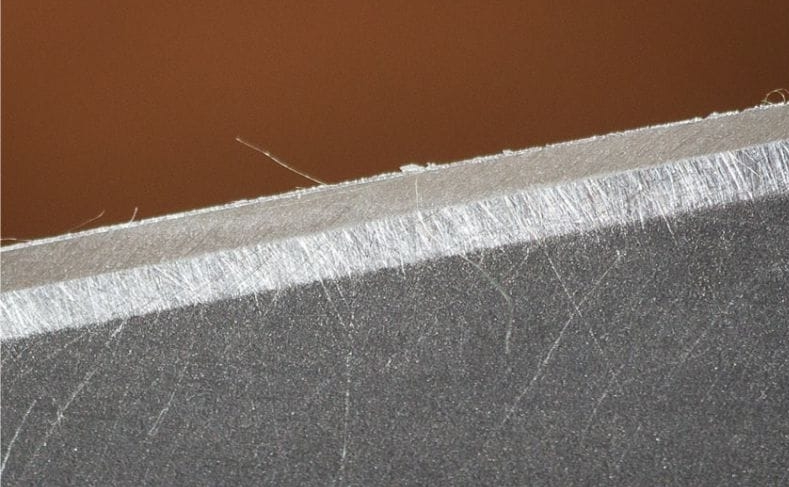
You will have to check the sharpness of the blade by cutting a sheet of paper or a tomato with it.
Finally
Now you know that the correct sharpening of knives is a simple task. The main thing is to choose the right tool and learn how to use it. You will find visual instructions for sharpening knives in the video in this article.
If any nuances on the topic remain unclear, ask questions in the comments - I will be happy to help.
A normal man must be able to cook meat, and also, he must keep the knives perfectly sharpened in the house. Yes, and the knives themselves should not be from any kind of garbage metal :)
Are you good at sharpening knives? To sharpen so that they can cut hair or shave without pressure? If in your house from "grinding accessories" there is only a hundred-ruble musat or a rough, cheap abrasive "stick" from a hypermarket, then the words "correct sharpening" are definitely not about you. Did you know that good whetstones are more expensive than other expensive Japanese knives, and for proper sharpening, you need to change several of them, using stones of different abrasiveness?
On many sites, and especially on the pages of online stores or knife catalogs, you can find a description of the sharpening process. But, as usual, there is a lot of PR because of which it is not always clear whether this is an advertising article or really valuable advice. That's why I put together some interesting links and an impressive video series.
Heating the paste (shown in the video), the author begins to polish the cutting edge, making 100 movements. Since the burr does not occur during polishing, the author polishes the blade "with a margin", noting that "the main thing at this stage is not to round the cutting edge." Further he writes:
This is what everyone actually does at this stage, hence all the talk about the "soapy" cut of polished blades. In fact, almost all RK are rounded off and this makes it dumber, hence the "soapy" cut. It is necessary, firstly, not to press, and secondly, to hold the blade so that the very edge of the RK barely touches the surface of the skin. Here it is better to be patient and take your time, it will still be polished over time and you don’t need to use force - you need to meddle and everything will be fine.
Just be careful, there are so many PR articles on this site that the brain can't stand it :)
Another interesting article on the Ukrainian site kombat.com.ua. Talks about steel, bars, methods, etc. Did you know that:
... there are no universal knives. Therefore, the sharpening angle of each knife depends on the purpose of the latter. If they are going to cut cheese, bread, sausage with a kitchen knife, and it’s enough for a worker soft materials(leather, paper, linden wood), the sharpening angles of such knives are minimal. If the knife is supposed to cut meat, frozen fish, or the knife is designed for carving oak, then the sharpening angles here will be larger (30 - 45 °). It is difficult to provide one or another angle of sharpening the blade of a knife or other tool without the appropriate skill ...
The eternal problem associated with blunt knives is actually quite easy to solve. And far from the fact that self-sharpening products are purchased, but directly manual sharpening knives at home.
If earlier all men knew how to sharpen kitchen knives, then in modern world most of them do not have enough idea how to do it.
Existing types of knives that do not require sharpening
Surely you know the saying - "what kind of owner, such in his house and knives." That is why many women are often outraged, speaking out about the lack of a “real man” in the house.
In order not to get into this situation, not to become this “fake”, you should familiarize yourself with the information below. You will learn not only how to properly sharpen a kitchen knife, but also what types of knives are, and also consider sharpening tools.
magnetic layer
- This type of knives cannot be sharpened for one simple reason - the blade is covered with a special metal layer, which includes a magnetic alloy. The surface of such a product remains sharp for a long time, the owners will not experience a problem with sharpening for a very long time.
- Sharpening a kitchen knife with a magnetic alloy is terrible because the entire surface layer will be deformed, more worn off. This will lead to rapid wear and loss of original sharpness.
Note! The price of such knives is much higher than for ordinary metal ones, but their service life allows them to remain popular. Anyway, the magnetic alloy knife does a good job of slicing food.
Ceramic knives
- Another type of knives that do not require sharpening. They are made of ceramic and honed to special machines. You can see the first-class products in the photo below.
- positive moment you can call their hardness, the blade is a little worse than a diamond-coated product, which is able to cut even the toughest objects.
- But on the other hand, ceramics do not have increased strength and flexibility, so such a knife is easy to break if the blade is slightly bent. Fall from the height of the working surface onto the floor from ceramic tiles, for such a knife is equivalent to hitting the blade with a hammer.
For your information! When buying such a product, be sure to check the presence of zirconium oxide in it, which allows for a slight increase in flexibility.
Serrated surface
- Hard wear-resistant steel is an excellent material for making kitchen knives from it. It has increased strength and protection against deformation, which makes this product popular in the modern market.
- The serrated edge in some cases significantly exceeds the smooth edge, so, for example, serrated knives cut cheese and sausages better. However, remember that not all products are best cut with a jagged edge.

- Unfortunately, it is impossible to sharpen such a knife with your own hands, otherwise the teeth will be damaged, and their uniformity will also be disturbed.
Important! To sharpen a knife with a serrated edge, you will need a kitchen knife sharpening machine, which costs a lot and is rather bulky. Therefore, sharpening such a product will significantly affect the budget, it will be easier to buy a new one.
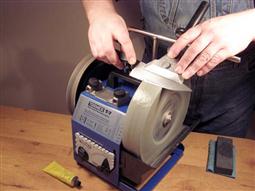
All kinds of tools
Don't know how to sharpen kitchen knives?
It doesn't matter, there are several various ways and tools:
- Steel or ceramic rod called mussat. Actually it is made from the above-mentioned materials, on top of which a diamond coating is applied. Outwardly, it resembles a round file, only such a tool is used to a greater extent for straightening knives, and not for sharpening.
![]()
- The whetstone is the most common tool that appeared in the kitchen several decades ago.. Stones differ in grain size, coarse (large grains) are designed to align the angle, correct the shape of the cutting part. Medium grains are used to restore the original shape at the edge, and fine-grained stones for the final finishing of the knife to working condition.
- Sandpaper can replace the whetstone. Unfortunately, it does not sharpen so well, so it is best to use only fine-grained blades. They will not damage the product and will not disturb the edge angle. But this is the cheapest sharpener for kitchen knives.
- special device, which has become very popular in modern times - a plastic case in which metal disks are built. If you insert a knife between them, and make several movements back and forth, you can not only correct the edge, but also eliminate defects. The main advantage of such a device is that it can withstand the correct sharpening angle of kitchen knives, which is 10-20 degrees.
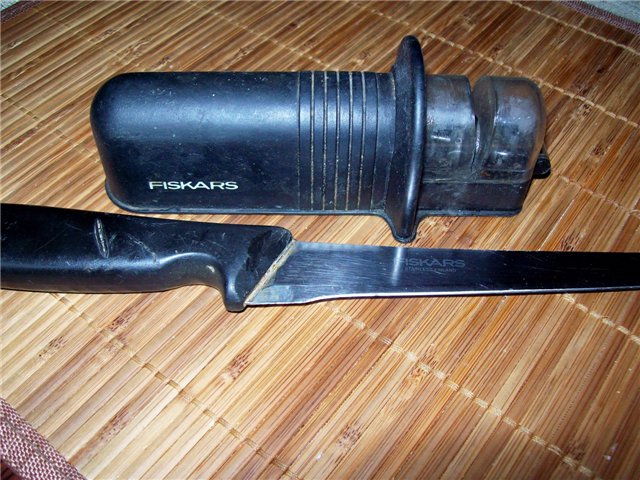
The most common device that can easily be edited with a dull knife
As you can see, you can restore the former sharpness of the knife on your own at no cost. And if you do not know how to properly sharpen a kitchen knife, then the entire process of sharpening and editing will be described in detail below.
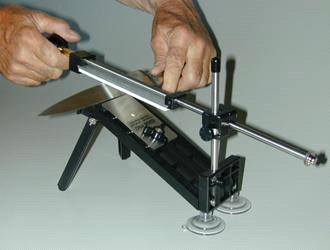
Proper dressing and sharpening
If you recently bought a knife, and it has become a little dull, then for this case you can use a muscat or a device that is sold in every hardware store (see also the article about). However, it should be remembered that this is only editing, soon the knife will still lose its sharpness, and then it will be necessary to sharpen the product.
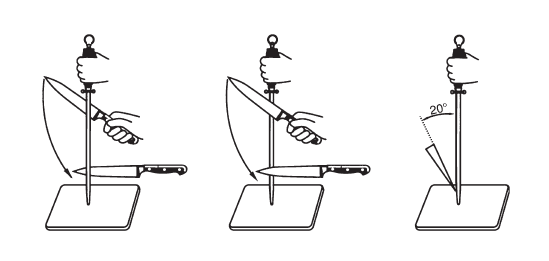
To return the product to its original appearance, you must follow what the instructions say on how to sharpen a kitchen knife at home:
- First of all, take a knife in your hands and clean it of dirt. Rinse the product thoroughly to remove all excess elements from the surface. Water should be cold, cooled steel is better sharpened.
- Then take out a whetstone with a middle tooth. It must be clean and dry.
- Depending on how you are going to sharpen the knife, you should maintain a certain angle. All knives for fine work are sharpened at the most acute angles, the minimum value is 10 degrees, the maximum is 20. For household items, the angle can be increased to 30 degrees.
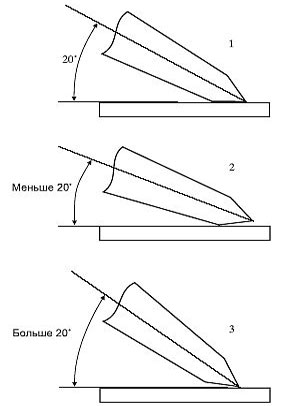
- Lead should be with a sharp edge forward, gradually from the handle to the tip. Movements should not be abrupt, although you should not drive slowly.
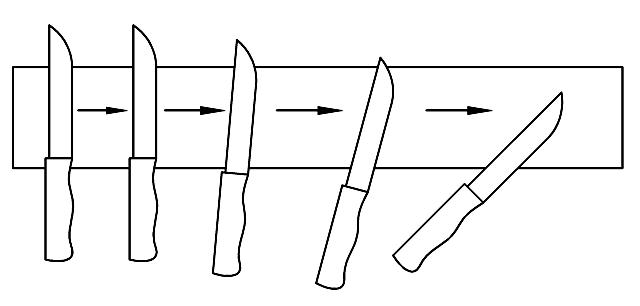
- Each side should be sharpened evenly. Therefore, watch how much you make movements on the grindstone on one side, and how much on the other.
Note! In some cases, sharpening can be done asymmetrically, for example, it will take 30 movements on one side and 60 on the other. This is due to the characteristics of the knife, the easiest way is to stick to symmetry.
- You should also maintain the sharpening angle of the kitchen knife, if you make 10 degrees on one side and 30 on the other, then the product can be considered damaged.
- After you have achieved the desired result, you should set aside a stone with a middle tooth and pick up a fine-grained canvas.
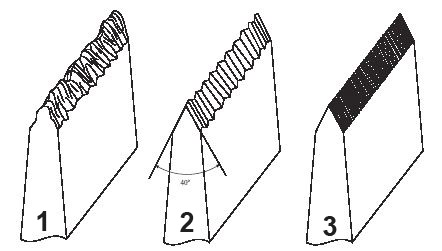
- This process is more accurate, the movements should not be sharp, no jerks.
- The effect of sharpening on a fine-grained canvas is visually difficult to notice, but know that this way you will make the product as even as possible. Plus, the knife will last longer.
Now you know how to sharpen kitchen knives at home. There is nothing complicated in this, the main thing is to follow the above recommendations.
Important! It should be remembered that the quality of the knife and its durability depend on the sharpness of the edge. If the blade is sharpened improperly, it will quickly become unusable.
Also, do not forget that all knives have a certain lifespan. Some can last 3-4 full-fledged sharpenings, after which they can no longer be restored at home. And other products, such as self-sharpening kitchen knives, are designed to last in years rather than cycles of sharpening and dressing.
If there is nothing at hand
There are also situations when there are no whetstones, no devices, no sandpaper at home, what to do in this case? Is it really left to turn only to specialists and pay for services to workers of workshops where no one guarantees quality?
However, there is one option that can be used in a hopeless situation. To do this, you need a ceramic mug.
Note! This method is only suitable for dressing knives, that is, for a short-term restoration of the sharpness of the blades. It will not be possible to completely restore the original sharpness of the blade in this way.
- Take a knife and soak it in ice water so that the blade is cold.
- The mug should be washed and the bottom should be wiped dry.
- Turn over and place the mug on the table.
- The knife should be driven alternately, first with one side, then with the other. It is not advisable to press hard so that the blade does not bend.
Flaw this method- the bottom of the mug will be damaged, any paint will quickly be erased. But the method is very effective, and besides, it is also simple.
Conclusion
Sharpening knives is a male occupation, but if a man is not around, and a sharp object is simply necessary in the kitchen, then after reading this article, any woman will cope with the sharpening process (Learn also about). If you have any doubts and questions, you can watch the video: how to sharpen kitchen knives, which is attached to the article. Visual lessons allow you to more accurately learn the sharpening technique.











Chicken in kefir - recipes for marinated, stewed and baked poultry for every taste!
Simple Chicken Recipe in English (Fried) Recipes in English with translation
Chicken hearts with potatoes: cooking recipes How to cook delicious chicken hearts with potatoes
Recipes for dough and fillings for jellied pies with mushrooms
Stuffed eggplant with chicken and mushrooms baked in the oven with cheese crust Cooking eggplant stuffed with chicken